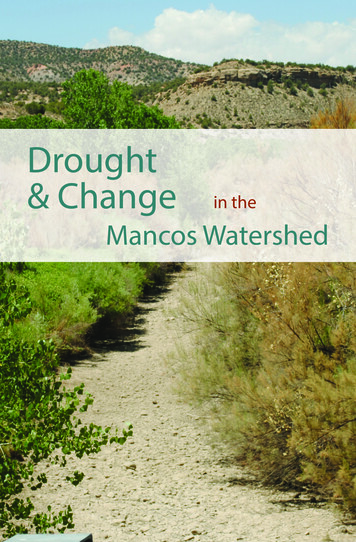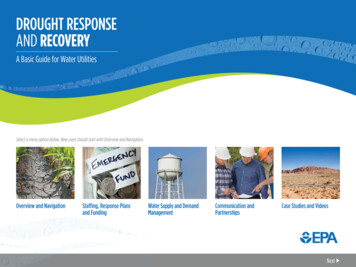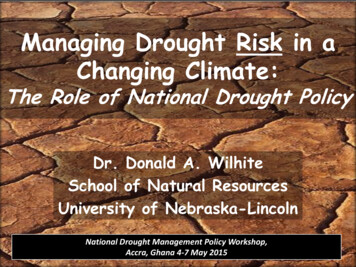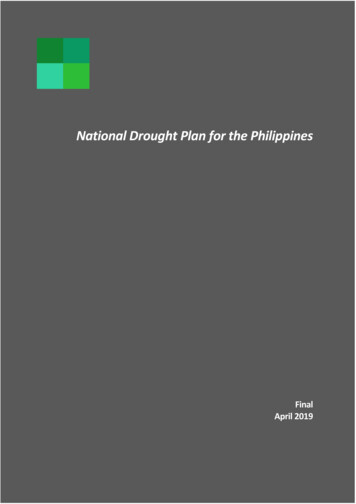
Transcription
Drought& Changein theMancos Watershed
Drought in the Mancos WatershedIn 2018, communities in the Mancos watershed were hit hard by drought.Lesser precipitation and higher than average temperatures impactedfarmers, ranchers, subsistence activities, fish and municipal uses in profoundways. According to the U.S. Department of Agriculture, Montezuma Countyexperienced “exceptional drought.” And while drought is not new to the Mancoswatershed, the increased frequency and severity of drought is indicative of moresweeping changes.Over the last 30 years, southwest Colorado has warmed significantly. Averagetemperatures in some places have increased by between 1-3 degrees Farenheit( F). In addition to warming, experts anticipate that climate change will result inprolonged drought, earlier snowmelt, decreased flows, and more severe wildfire,similar to conditions experienced in 2002, 2012, and 2018.Following the 2012 droughtThough it’s fresh in our memory,and the Weber Fire, thethe 2018 drought wasn’t unique.Mancos River ResilienceWe experienced similar droughtsGroup formed to examinein 2002 and 2012, and the communityboth climate and nonunderstands that drought is part ofclimate related changes—life here. But droughts like the one inlike population growth and2018 have a profound impact on thechanging economies—in theriver and those who rely on it, and if wewatershed. Our purpose isdon’t prepare for future droughts, thoseto identify resources andimpacts may be intensified.strategies to prepare for—GRETCHEN RANKand mitigate the impacts ofExecutive Director, Mancos Conservation Districtfuture droughts. This bookletaims to bring you the latestclimate science, inspire dialogue, and promote drought resilience efforts thatsupport all values in the Mancos watershed.Palmer Drought Severity Index Montezuma County, CO
How do droughts impact the Mancos Watershed?The impacts of drought on people living and relying on the Mancos watershedvary widely. For farmers and ranchers, debt, soil health, the price of hay, seniorityof water rights and size of land all contribute to the impacts of drought. Forthe Ute Mountain Ute Tribe, drought creates major challenges for subsistenceactivities. Temperature, monsoons, and the history of drought heavily influencefish and cottonwood populations. While everyone (and everything) in theWatershed may experience drought differently, the reality is that droughts likethose that occurred in 2002, 2012 and 2018 impact everything.Some ranchers in Mancos estimate it takesbetween 7-9 years to recoverfinancially from drought.Many local irrigators let their fieldsfallow and sought alternative forms ofincome in response to the 2018 drought.Some found jobs in nearby towns, andsome were forced to sell their land.Cottonwoods that were alreadystressed from the 2012 droughtwere made increasingly vulnerable in 2018.A survey by CO Parks and Wildlife in 2018found very few warm or cold waterfish species in the Mancos. Wherethere were pools, they were disconnected,posing significant habitat and reproductionchallenges.Under hotter climatescenarios, droughts likethe one we experiencedin 2018 are expected tooccur every 5-7 yearsbetween 2020 and 2050.
The Mancos watershed is unique for the diversity of history, terrain, species,cultures, and economic industries it encompasses. More than 2000 years ago,humans first called the Valley home. Now, roughly 2,400 people who live,gather traditional plants and herbs, have small farms and sweeping ranches,brew beer and cider, craft arts and build pack rafts call the town of Mancoshome. Downstream, Mesa Verde National Park brings in over half a millionpeople every year. Further downstream, the Ute Mountain Ute Tribe relies onthe river for cattle ranching and cultural traditions. Native fish like blueheadand flannel mouth sucker rely on flows in the river, as does a diverse array ofwildlife.As it has for most of its history, the Mancos watershed continues toexperience tremendous changes. And, while some of those come inthe form of human development and population growth, some ofthe most significant impacts to the watershed will come fromthe increased frequency and severity of droughtMesa Verdeassociated with climate change.National EcologicalAgriculturalUte MountainUte Tribal ParkWarm Water FishWater volume is significantlyreduced downstream due toincreased use and drought.SUBSISTENCE & GATHERINGWarming temperatures have caused changes in the abundance, distribution,and health of wildlife and plants used by Ute Mountain Ute people for foodand traditional activities.
UPPERCLIMATE VULNERABILITIESWater SupplyEcologicalWhile values differ throughout theMancos Watershed, each sub-basinis vulnerable to increasing droughtconditions like rising temperatureand decreased winter snowpack.Mt. Hesperus13,232 ftSnowpackJackson lMunicipalEcologicalGROUNDWATER RECHARGEWinter SnowfallSnowpack melts as weather warmswater returns to surfacethrough seeps and springsWater seeps slowly into soilGroundwater is replenishedWhile spring rains are important for groundwater recharge,the most ideal source is the slow melting of snowpack.
How climate change is expectedto impact the Mancos Watershedduring the next three decadesIn order to better understand how a changing climate will impact our future,scientists have developed a range of plausible scenarios based on 70 differentclimate model projections.While climate change under each scenario is distinct, several common patternsemerge which could lead to significant impacts in the Mancos Watershedbetween 2020 and 2050.In addition to the 2 degree Fincrease in average temperaturesthat the Mancos watershed alreadyexperienced between 1985 and 2015,annual temperatures in the areawill increase by another 2 to 4degrees over the next 30 years.In winter, temperatures willincrease by 1.5 to 6 degreesThe snowline/freezing line willshift up in elevation by 400 to1800 feetPeak spring runoff will occur 10to 20 days earlierSummer soil moisture willexperience a decrease between-20% and -60%Frequency and severity ofwildfires will increase, andwildfire season could expand by asmuch as one month
Learn more, get involved, plan and preparePlanning for drought and the future impacts of climate change can becomplicated and overwhelming, but people are taking small measures every dayto protect the things they care about. To learn more, visit:Mountain Studies Institute website: http://www.mountainstudies.org/Colorado Natural Heritage Program: National Climate Change Viewer: https://www2.usgs.gov/climate landuse/clu rd/nccv/viewer.aspNorth Central Climate Adaptation Science Center: https://casc.usgs.gov/centers/northcentralNOAA Palmer Drought Index: istorical-palmers/National Integrated Drought Information System: https://www.drought.gov/drought/Drought Index Comparison Portal: https://climate-scatterplot.space/Stay tuned by becomingpart of the Mancos RiverResilience Group. Sign up at:www.mountainstudies.org/waterandsnowwork/mancos
We are privileged to live in some of the mostbeautiful and vibrant landscapes on earth.With this privilege comes the responsibilityfor treating our natural heritage with care. Giventhe record low precipitation and record hightemperatures since 2000, drought has had a majorimpact on the natural resources that sustain us.The Mancos River Resilience Group has taken upthis challenge. This level of collaborative, inclusive,community-based and science-based stewardship isthe key to handing off the gifts we have received tothe next generation with a level of resiliencethat they can build their future on.—MIKE PRESTON San Juan Basin RoundtableMountain Studies Institute produced this drought andclimate education booklet with funding from the Bureau ofReclamation and with support, information and feedback fromnumerous partners including:679 E. Second Avenue, Suite 8 Durango, CO 81301 mountainstudies.org
climate science, inspire dialogue, and promote drought resilience efforts that support all values in the Mancos watershed. Though it's fresh in our memory, the 2018 drought wasn't unique. We experienced similar droughts in 2002 and 2012, and the community understands that drought is part of life here. But droughts like the one in










